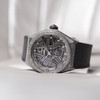Since 1675, when the balance wheel with hairspring and anchor first appeared in clocks, the design of this regulating device has not changed much. Now, Zenith Defy Lab has arrived with its silicon oscillator, replacing the classic design of approximately 30 components with a single monoblock offering multiple times the power, longer life, and energy savings. There are few watchmakers in the world who have dared to take such a bold step.

After 152 years of existence, Zenith is opening a new chapter in the history of the Swiss watchmaking industry. Connoisseurs will surely remember its first chronograph, El Primero, from 1969, with a balance wheel operating at a frequency of 5Hz, which increased the accuracy of the mechanical movement to an unprecedented 0.1 seconds. El Primero movements are often referred to as a legend of Swiss watchmaking, reflecting the quest for maximum precision through bold inventions and innovations.
The Zenith Defy Lab is another historic milestone on this journey. It is an invention that improves on the regulating principle of the balance wheel with a hairspring and anchor, invented by Christiaan Huygens, which normally consists of about 30 parts. Here, it is replaced by a single component of a relatively complex shape that performs the functions of the anchor, hairspring, and crown. This radical reduction in the number of moving parts has eliminated friction and wear, meaning that no oil or other special maintenance is required. Unlike a conventional oscillator, it also requires no assembly, adjustment, timing, or testing. A team of engineers from the watchmaking division of LVMH (Moët Hennessy Louis Vuitton) led by the brilliant designer Guy Sémon, who does not consider himself a watchmaker despite having a number of ingenious inventions for the avant-garde watch brand TAG Heuer to his credit, participated in its development.

The oscillator in Defy Lab is made of monocrystalline silicon. Thanks to the exceptional physical properties of this material, it has been possible to achieve perfect resistance to temperature fluctuations, gravity, and magnetic fields, as well as very favorable dimensions. The thickness has been reduced from the usual 5 mm to just 0.5 mm, and some details are finer than a human hair.
The oscillator operates at a frequency of 15Hz, i.e. 108,000 vibrations/hour, which gives the watch up to 10 times the measurement accuracy of the standard. Their average time deviation is around 0.3 seconds per day. By comparison, one of the criteria for COSC certification for chronographs is a deviation of -4 to +6 seconds. It maintains its accuracy for 95% of its running time, unlike most mechanical watches, which lose their endurance and accuracy after just 24 hours. Despite this above-standard high frequency, the power reserve is up to 60 hours, which is approximately 10% more than in El Primero watches.
The shape and movement of the oscillator are clearly visible through the skeletonized dial. The case has a diameter of 44 mm and is made of porous Aeronith aluminum alloy. It is an extremely hard metal foam produced using relatively complex technology. Its density is only 1.6 kg/dm3, making it 2.7 times lighter than titanium, 1.7 times lighter than aluminum, and 10% lighter than carbon fiber.
Only 10 Defy Lab watches have been produced in the Zenith workshops so far, each in a different color combination. They come in special gift packaging and have all been sold or reserved.






